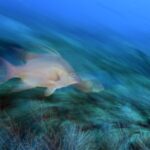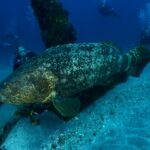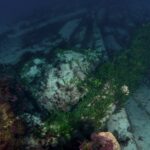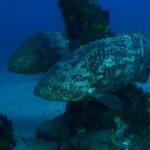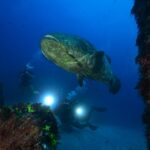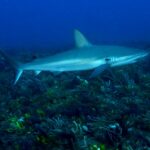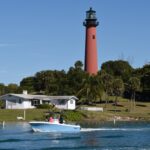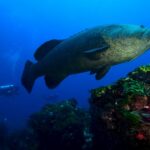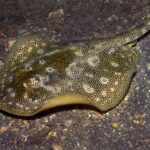Boom!
As we drifted towards the designated wreck site of the MG-111 off the east coast of Florida, we looked around and wondered, “What the heck was that?”
It was a loud thump coming from behind the limit of visibility and striking us in the water column.
Boom! Boom!
There it was again.
Suddenly, as we drifted further along in the north-moving Gulf Stream, our eyes began to make out the distant shapes of giants. First one, then several, then an entire troop patrolling the mangled remains of a river barge scattered along the sandy bottom. We had found our quarry: The Goliath Groupers of Florida.

The face of a Goliath Grouper
Words & Photos by Michael Salvarezza and Christopher P. Weaver
Our expedition began earlier in the day as we loaded our gear in the sweltering August heat of South Florida onto the Jupiter Dive Center dive boat Republic IV. With temperatures approaching 100, the warm 87-degree Atlantic water still sounded as if it would be refreshing! We were excited and, as the boat exited the inlet under the watchful eye of the Jupiter Lighthouse, the anticipation of diving with these elusive creatures began to grow.
Goliath Groupers were once plentiful along Florida’s east coast, throughout the Caribbean and north to Bermuda. Spearfishing and unchecked fishing seriously reduced their populations until protections were granted in 1990 in the United states and 1993 in the Caribbean. Although the populations have rebounded, Goliath Grouper are slow to mature and reach sexual maturity and this makes the recovery of the species difficult. Despite this, and over the objections of environmentalists and divers, Florida has approved the re-opening of Goliath Grouper fishing under very strict controls and this is expected to resume in 2023.
These fish are the largest reef fish seen in these waters, measuring up to 8 feet in length and weighing in at a massive 800 pounds. Preferring areas of rock, coral and silty, muddy bottoms, the Goliath Grouper are generally solitary in nature. However, each year, between June and September they aggregate off the coast of Jupiter, Florida and along the south Florida coast to spawn.

The Jupiter Inlet Lighthouse bids divers good luck as they depart for the dives
A territorial fish, Goliath Grouper do defend their turf and their mates. Open mouth displays and a quivering body may be followed by a low, rumbling bark that can carry great distances through the water. That is what we were hearing as we descended through the water column to the wreck site.
Diving along these coasts is usually done as live boat drift diving. To conduct the dive safely and to maximize our chances of seeing the Goliath Grouper, the captain dropped us in well upstream from the wreck, which allowed us to drift right into it. As the rubble of the wreck came to view, so did the behemoths of the deep who seemed to anticipate our arrival. Goliath Grouper do not usually pose a danger to divers, but they have been known to approach and even stalk divers, and they will seek to defend their territory. For this reason, large individuals should be treated with caution.
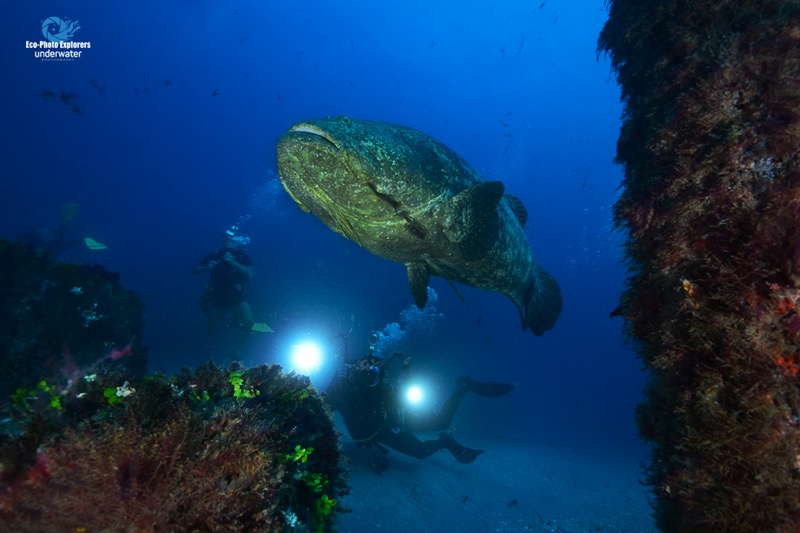
Goliath Grouper are often unafraid of divers
We found a seemingly indifferent pair hanging around a set of columns from the MG-111. Almost as if posing for the paparazzi, they remained still as we circled the six-foot fish and contorted ourselves to get the best angle for a Goliath Grouper portrait. Perhaps these two were occupied with thoughts of spawning and couldn’t be bothered with these strange, bubble blowing intruders.
Another group was stationed some distance away in the sand, keeping a wary eye on the proceedings. They were less sanguine and quickly retreated when we attempted to approach.
The currents can be strong here, so proficiency with a Surface Marker Buoy (SMB) is essential, especially if you drift away from the main group. Our first dive ended with a count of 13 Grouper and, as we drifted along on our safety stop, we were content with knowing how fortunate we were to have visited with these giants.
The Jupiter Dive Center visits other wrecks during this season to spot aggregating Goliath Grouper. The Zion Train, a small sunken freighter, The Miss Jenny, an upside-down barge, and the Esso Bonaire, an upright wreck with open cargo holds and cabin area, all produce fairly reliable Grouper sightings.
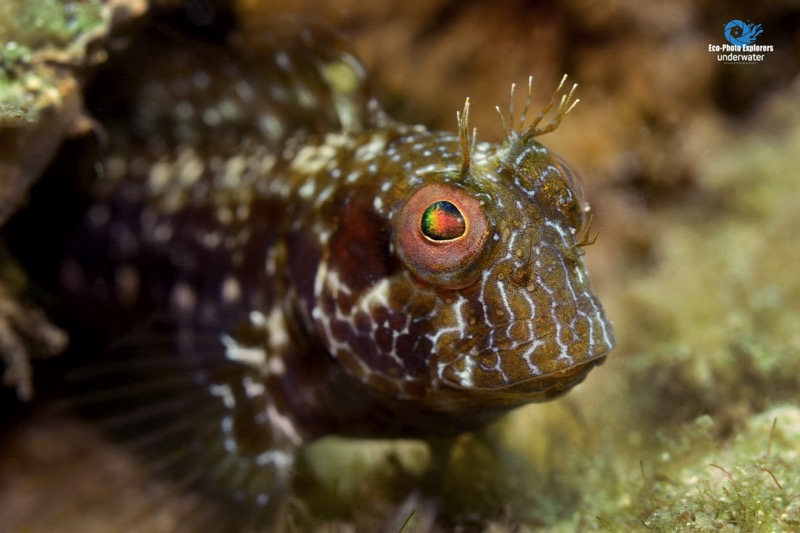
Blennies, like this Hairy Blenny, can be spotted by looking closely at the rocks and coral structures of Florida’s reefs.
Our next dive, however, was to a place called Tunnels. This is a beautiful reef system named for three small swim-throughs or tunnels that can be found here. A ledge that extends north-south and bottoms out at a maximum of 75 feet, this is another spot to find Goliath Grouper. As we descended to the reef, we immediately came across a pair of the large fish. One, likely a female, was smaller (about 4 feet in length) than the other, a male about 5 feet in size, which was shadowing her closely. Suddenly, as we approached, the large male began to swim directly towards us and, when he was just a few feet away, snapped his jaws and barked deeply in our direction. The message was received and we backed away to leave them their space.
The dive along Tunnels is a highlight of diving in this area. Many of the commonly seen reef denizens can be found here, but we were in search of more Grouper. In what seemed as if it was a practical joke, we did not see any more Goliath Grouper on this dive…. until we stopped to begin our ascent in the current. And there, trailing right behind us was perhaps the largest Goliath Grouper we had seen on the trip! He had to be in excess of six feet in length and upwards of 500 pounds. We had no more bottom time left, we were low on air and this was when he decided to show himself! We raised a fist in his direction, playfully, and then departed into the ocean current. Our expedition was a success.

Goliath Grouper can dwarf divers
The aggregation of Goliath Grouper is a unique experience for scuba divers. These giants are thought to live upwards of 50 years, and when you see one on the reef gazing out you with the wisdom of decades, a sense of respect and wonder envelopes you. In spite of their size and fearsome appearance, their diet consists mainly of crustaceans, fishes, octopus and young sea turtles. Still, divers should exercise some caution, especially when the fish is defending its territory.
Goliath Grouper, like many groupers, are protogynous hermaphrodites. This means that individuals first mature as females and only later in life do they become males. This, along with many other fascinating traits, makes the Goliath Grouper a must see for divers.
These fish, once hunted to near extinction, are now coming back. They aggregate along the east coast of Florida. In Jupiter, West Palm Beach, Deerfield Beach and Pompano Beach, there are many sites that are favored by these giants. There are a number of dive boats that operate out of all of these areas and that can take you to see one of the wonders of the sea…the annual gathering of the giant Goliath Grouper.
Words & Photos by Michael Salvarezza and Christopher P. Weaver
- Swift currents create great drift dive opportunities
- Jupiter Dive Center boats preparing for a day of diving
- A diver videos a Goliath Grouper
- Goliath Grouper can dwarf divers
- Goliath Grouper hanging around wreckage of the MG-111
- The MG-111 is an old broken up Mississippi River barge that sits in about 65 feet of water.
- The face of a Goliath Grouper
- Blennies, like this Hairy Blenny, can be spotted by looking closely at the rocks and coral structures of Florida’s reefs.
- Wreckage covered in a kaleidoscope of color
- A pair of Goliath Grouper on the MG-111
- Aggregations of Goliath Grouper are predicable in the summer months
- Goliath Grouper are often unafraid of divers
- A Queen Angelfish dodges into the reef
- A small blenny peers out from his nook upside down
- Reef Sharks patrol the reefs
- The Jupiter Inlet Lighthouse bids divers good luck as they depart for the dives
- Goliath Grouper make a distinctive booming grunt
- A Yellow Stingray scours the bottom

